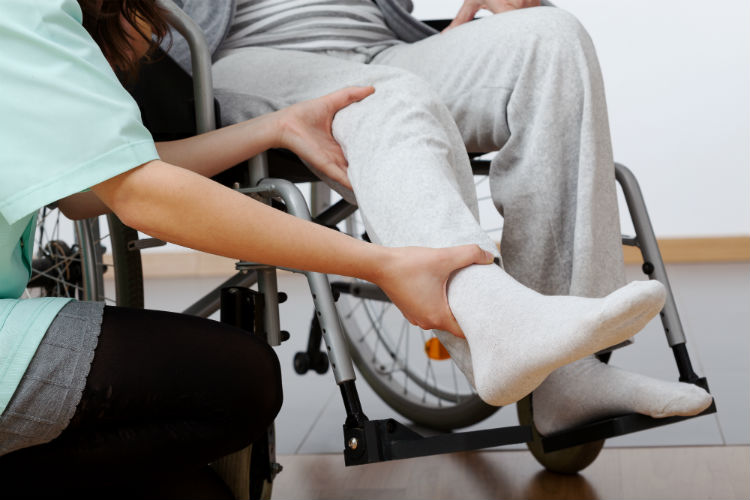By understanding what rehabilitation services have to offer, you can make well-informed choices.
What is physical therapy?
Physical therapy (sometimes called PT) can help enhance mobility and quality of life by improving strength, balance, endurance, flexibility and posture. Physical therapy can maximize your loved one's ability to get around at home and community, as well as participate in favorite recreational activities.
Where can I get physical therapy, and what happens during the sessions?
Physical therapy services are available in multiple settings including the hospital, rehabilitation center, nursing home, outpatient clinic, adult medical day care, and at home.
In the hospital, rehab hospital or long-term care facility, most treatment sessions take place either in a hospital room or "therapy gym." The goal of physical therapy in these settings is typically to improve function so that the patient is safe to return home with assistance. Your loved one may perform exercises lying down in bed or on a padded mat table to improve ability to get in and out of bed. Doing exercises with weights while sitting increases one's strength and ability to get out of a chair, while exercises with weights while standing improve strength, balance and ability to walk. Very often "parallel bars" are available to provide support for both hands as the patient practices walking.
Physical therapy in an outpatient facility is usually for people who aren't homebound and are able to tolerate a much higher level of activity. It often includes a variety of exercise equipment and machines to improve strength and balance. You may see stationary bicycles, treadmills, arm bikes as well as machines like the leg press. Don't worry – the physical therapist will explain exactly how to use the machines properly and safely at the appropriate amount of weight and resistance for your relative.
Physical therapy in the home may be for those who are unable to leave home due to their medical status. It may also be for people who can get out and about, but logistical issues such as lack of transportation make it difficult to get to an outpatient facility consistently. The goal for PT at home is to maximize function at home and community to improve quality of life. Your loved one may do strengthening exercises lying on the bed, sitting in a chair or standing at the kitchen counter with weights or exercise resistance bands. Balance exercises may also be part of the mix. Your relative may practice going up and down your stairs, getting in and out of the car and walking in the neighborhood.
What is speech therapy?
Speech-language pathology services (SLP) boost a person's ability to communicate and to swallow.
In our society, it's a common comfort to sit down and have a great conversation with family and friends over a great meal. That requires two essential skills: the ability to swallow, and the ability to communicate. Both are absolutely critical to a good overall quality of life.
Nearly all activities of daily life require us to communicate, interact, and process information. Communication skills are necessary not only to convey wants and needs, but to socialize and connect with others.
What conditions can benefit from Speech-language pathology?
SLP addresses the declines associated with the aging process, such as neurological difficulties, age-related illness, and deterioration of the swallowing mechanism.
SLP may be able to help your loved one with declines due to brain injury, stroke, cancer, infection, or physical abnormality. It's used to treat breathing problems due to lung diseases or tracheotomy.
Speech therapists also provide treatment of cognitive-linguistic impairments. This treatment focuses on restoring memory, sequencing, problem solving, safety awareness, attention, and their effects on the function of ADLs. Exercises may include breaking down a complicated task, like making a grocery list, to small simple steps. In this case, the steps include identifying what items you need (problem solving), finding a pen and paper, remembering the words for the items you want (memory), and writing the list (communication).
Does your loved one have trouble speaking, articulating words, or using expressive language? SLP can help in these instances, too, for conditions such as dysarthria or apraxia (motor speech disorders); hoarse or harsh vocal quality; complete or partial loss of voice; or aphasia (a language disorder).
Your parent may be taught specific exercises to strengthen the muscles of the face, mouth and throat such as blowing out, sipping in through a straw and making specific sounds like "pa" and "ma".
Finally, speech-language pathology plays a critical role in the treatment of dysphagia, or swallowing disorder. The treatment of dysphagia is essential in maintaining healthy lungs and avoiding pneumonia. Beyond that, a therapist may be able to help your loved one enjoy a less restrictive diet with a wider variety of foods.
PT, OT, and SLP are typically available to patients via a referral from their physicians. At my practice, Fox Rehabilitation, we have seen all three of these therapies restore and rehabilitate the lives of thousands of seniors. If you believe your loved one might benefit from PT, OT or SLP, I encourage you to research practitioners in your area and talk with your family doctor. In a few months, you may see your loved one recover abilities once believed to be gone, and rejuvenate in a way you might never have thought possible.
What is occupational therapy?
Occupational therapy (also known as OT) focuses on your ability to fulfill your "occupations." So for your parent, the roles could include mother, spouse, homemaker, grandparent, caregiver, or bridge player. Generally, OT assists with the ability to perform Activities of Daily Living (ADLs) such as getting dressed, toileting and bathing as well as Instrumental Activities of Daily Living (IADLs) such as driving, shopping, cooking and recreational activities.
What happens during occupational therapy?
Occupational therapy services are available in many of the same settings as physical therapy. The goal of OT in a hospital, rehab hospital or long-term care facility is often to improve function so that your loved one is safe to return home with assistance.
Treatment sessions, either in the hospital room or therapy gym, may focus on your parent's posture and use of her arms to improve her ability to eat, dress, bathe and perform other activities of daily living (ADLs). Exercises may include stretching and strengthening to make sure she has enough flexibility and strength to perform ADLs. A large part of OT is practicing, developing new strategies and using adaptive equipment to perform activities such as eating, dressing and bathing.
OT in an outpatient facility is not as common as outpatient physical therapy. When it's offered, outpatient OT is usually for injuries to the hand or arm to maximize function in ADLs, IADLs and recreational activities. Patients may use the arm bike, arm exercises with weights, or special "silly putty" to improve hand strength and dexterity.
OT in the home offers the same benefits as PT at home. The goal is to maximize your parent's ability to function in his home and community to improve his quality of life. OT at home can include training in doing laundry, light meal preparation, grocery shopping and driving.

